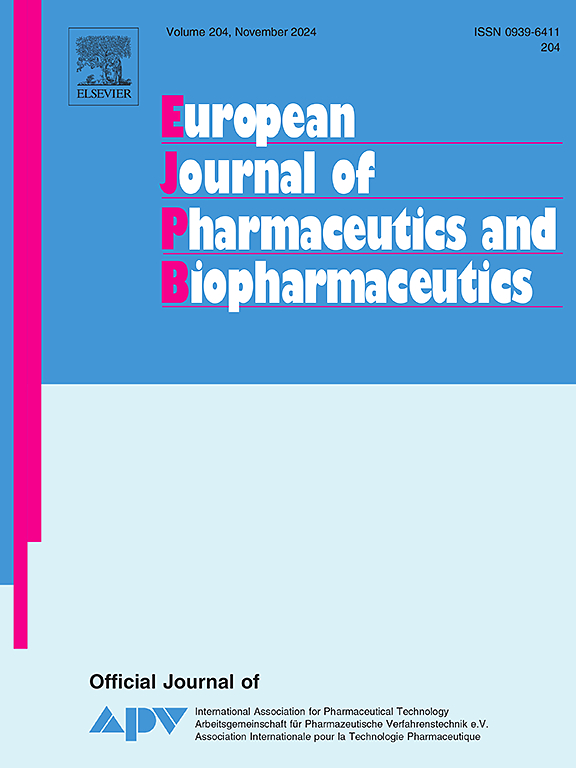Development of mucoadhesive films with high polaprezinc content for oral mucositis: A study on formulation and near-infrared spectroscopy-based quality control
IF 4.4
2区 医学
Q1 PHARMACOLOGY & PHARMACY
European Journal of Pharmaceutics and Biopharmaceutics
Pub Date : 2025-04-02
DOI:10.1016/j.ejpb.2025.114707
引用次数: 0
Abstract
Polaprezinc (PLZ) has drawn attention to its potential to prevent oral mucositis caused by chemotherapy and radiotherapy. PLZ-containing lozenges have been developed in previous reports; however, for patients with mucositis, taking them may be challenging because of pain. Therefore, this study aimed to develop a mucoadhesive film containing the same amount (18.75 mg) of PLZ as a lozenge as a new dosage form to replace lozenges and evaluate its characteristics. First, various films were created using solvent casting to screen polymers with high PLZ content. Thus, hydroxypropyl cellulose (HPC) was selected; however, film curvature and reduced flexibility necessitated formulation optimization. The optimized films exhibited excellent content uniformity, stability, and mucoadhesive properties, with no significant changes in the drug content after storage. Furthermore, the possibility of using portable near-infrared spectroscopy (Micro NIR™) for the quality control of PLZ films was investigated. Multivariate analysis revealed that the Micro NIR calibration model predicted drug concentrations comparable to those measured by high-performance liquid chromatography. These results suggest that a mucoadhesive film with high PLZ content has been developed and that efficient quality control is possible using Micro NIR™.

口腔黏膜炎用高聚戊二锌黏附膜的研制:配方及近红外光谱质量控制研究。
Polaprezinc (PLZ)因其预防化疗和放疗引起的口腔黏膜炎的潜力而受到关注。在以前的报告中已经开发了含plz的含片;然而,对于患有黏膜炎的患者来说,服用它们可能会因为疼痛而具有挑战性。因此,本研究旨在研制一种含有相同量(18.75 mg) PLZ作为含片的粘接膜,作为替代含片的新剂型,并评价其特性。首先,采用溶剂铸造技术制备各种薄膜,以筛选高PLZ含量的聚合物。因此,选择羟丙基纤维素(HPC);然而,薄膜曲率和降低的柔韧性需要配方优化。优化后的膜具有良好的含量均匀性、稳定性和粘接性能,储存后药物含量无明显变化。此外,还研究了便携式近红外光谱(Micro NIR™)用于PLZ薄膜质量控制的可能性。多变量分析表明,微近红外校准模型预测的药物浓度与高效液相色谱法测定的药物浓度相当。这些结果表明,已经开发出具有高PLZ含量的黏附膜,并且可以使用Micro NIR™进行有效的质量控制。
本文章由计算机程序翻译,如有差异,请以英文原文为准。
求助全文
约1分钟内获得全文
求助全文
来源期刊
CiteScore
8.80
自引率
4.10%
发文量
211
审稿时长
36 days
期刊介绍:
The European Journal of Pharmaceutics and Biopharmaceutics provides a medium for the publication of novel, innovative and hypothesis-driven research from the areas of Pharmaceutics and Biopharmaceutics.
Topics covered include for example:
Design and development of drug delivery systems for pharmaceuticals and biopharmaceuticals (small molecules, proteins, nucleic acids)
Aspects of manufacturing process design
Biomedical aspects of drug product design
Strategies and formulations for controlled drug transport across biological barriers
Physicochemical aspects of drug product development
Novel excipients for drug product design
Drug delivery and controlled release systems for systemic and local applications
Nanomaterials for therapeutic and diagnostic purposes
Advanced therapy medicinal products
Medical devices supporting a distinct pharmacological effect.

 求助内容:
求助内容: 应助结果提醒方式:
应助结果提醒方式:


